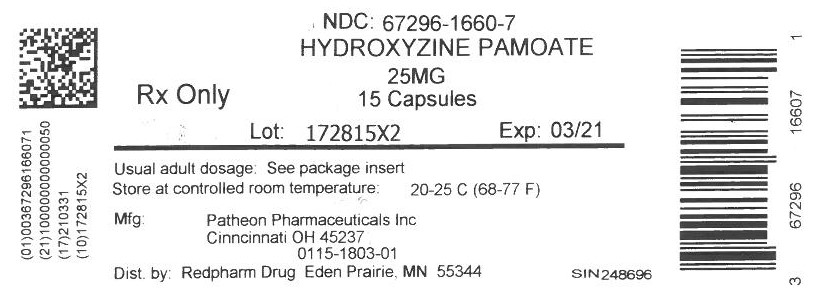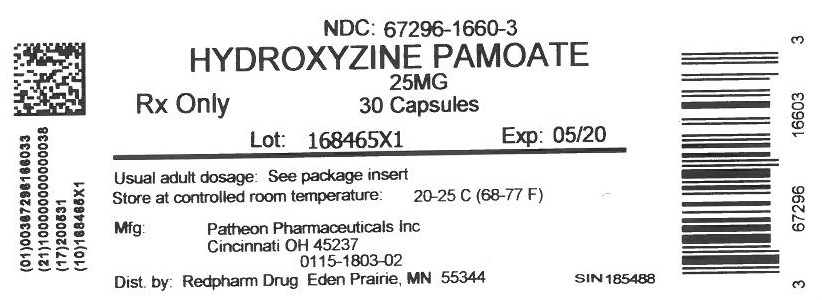Drug Catalog - Product Detail
HYDROXYZINE PAMOATE 25MG CP 100CT
| NDC | Mfr | Size | Str | Form |
|---|---|---|---|---|
| 00115-1803-01 | AMNEAL PHARMACEUTICALS | 100 | 25MG | CAPSULE |
PACKAGE FILES




Generic Name
Substance Name
Product Type
Route
Application Number
Description
DESCRIPTION Hydroxyzine pamoate is a light yellow, practically odorless powder practically insoluble in water and methanol and freely soluble in dimethylformamide. It is chemically designated as 1-(p-chlorobenzhydryl) 4-[2-(2-hydroxyethoxy) ethyl] diethylenediamine salt of 1,1’-methylene bis (2hydroxy-3-naphthalene carboxylic acid) and can be structurally represented as follows: Molecular Weight: 763.29 Each capsule, for oral administration, contains hydroxyzine pamoate equivalent to 25 mg or 50 mg of hydroxyzine hydrochloride. In addition, each capsule contains the following inactive ingredients: colloidal silicon dioxide, D&C yellow #10, FD&C blue #1, gelatin, magnesium stearate, pregelatinized starch, sodium lauryl sulfate, and titanium dioxide. The imprinting ink on the capsules contains synthetic black iron oxide. chemical structure and chemical formula
How Supplied
HOW SUPPLIED Hydroxyzine pamoate capsules, USP (hydroxyzine pamoate equivalent to hydroxyzine hydrochloride) are supplied as follows: 25 mg capsules: Dark green opaque cap/light green opaque body filled with yellow powder. Imprinted in black "IX" on the capsule cap and "657" on the capsule body, in bottles of 100 (NDC 0115-1803-01) and 500 (NDC 0115-1803-02). 50 mg capsules: Dark green opaque cap/white opaque body filled with yellow powder. Imprinted in black "IX" on the capsule cap and "658" on the capsule body, in bottles of 100 (NDC 0115-1804-01) and 500 (NDC 0115-1804-02). Store below 30°C (86°F) [See USP]. Dispense in a tight, light resistant container as defined in USP/NF.
Indications & Usage
INDICATIONS For symptomatic relief of anxiety and tension associated with psychoneurosis and as an adjunct in organic disease states in which anxiety is manifested. Useful in the management of pruritus due to allergic conditions such as chronic urticaria and atopic and contact dermatoses, and in histamine-mediated pruritus. As a sedative when used as premedication and following general anesthesia, Hydroxyzine may potentiate meperidine (Demerol ® ) and barbiturates , so their use in pre-anesthetic adjunctive therapy should be modified on an individual basis. Atropine and other belladonna alkaloids are not affected by the drug. Hydroxyzine is not known to interfere with the action of digitalis in any way and it may be used concurrently with this agent. The effectiveness of hydroxyzine as an antianxiety agent for long-term use, that is, more than 4 months, has not been assessed by systematic clinical studies. The physician should reassess periodically the usefulness of the drug for the individual patient.
Dosage and Administration
DOSAGE For symptomatic relief of anxiety and tension associated with psychoneurosis and as an adjunct in organic disease states in which anxiety is manifested: in adults, 50 mg to 100 mg q.i.d.; children under 6 years, 50 mg daily in divided doses; and over 6 years, 50 mg to 100 mg daily in divided doses. For use in the management of pruritus due to allergic conditions such as chronic urticaria and atopic and contact dermatoses, and in histamine-mediated pruritus: in adults, 25 mg t.i.d. or q.i.d.; children under 6 years, 50 mg daily in divided doses; and over 6 years, 50 mg to 100 mg daily in divided doses. As a sedative when used as a premedication and following general anesthesia: 50 mg to 100 mg in adults, and 0.6 mg/kg in children. When treatment is initiated by the intramuscular route of administration, subsequent doses may be administered orally. As with all medications, the dosage should be adjusted according to the patient's response to therapy.
